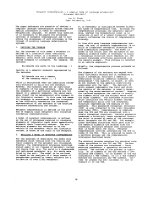initially scientists believed there was a special
Bạn đang xem bản rút gọn của tài liệu. Xem và tải ngay bản đầy đủ của tài liệu tại đây (7.16 MB, 56 trang )
ORGANIC CHEMISTRY!
Meaning of “Organic”?!
Initially scientists believed there was a special “force” in living organisms!
-this was assumed the unique component of organic material!
In 1828 Wöhler “synthesized urea (a known component of organic material)!
from inorganic ammonium cyanate!
Later Justus von Liebig, a noted 19
th
century chemist, declared the synthesis of urea!
“the very first beginning of the actual scientific organic chemistry”!
In a subsequent paper Wöhler and Liebig wrote:!
“sugar, salicin, and morphium will be produced artificially. Of course, we do not
know the way yet by which the end result may be reached since the prerequisite links
are unknown to us from which these materials will be develop -!
however, we will get to know them.”!
Organic chemistry is now considered the chemistry of carbon!
**Not only carbon!!
There are few forms of only pure carbon!
(no other elements present)!
Some examples of compounds with only carbon present:!
graphite! diamond!
C
60
spherical ball! carbon nanotube!
Carbon can form strong bonds with not only carbon but with other elements!
(e.g. hydrogen, nitrogen, oxygen, halogens)!
Depending upon the order of the bond connections (both constitution and configuration)
millions of compounds, all with potentially different properties, can be prepared!
Why is this so important?!
Almost every component of living organisms involve organic chemistry!
(proteins, enzymes, lipids, fats, carbohydrates, nucleic acids, etc.)!
And the metabolic and other interactions in the body involve organic reactions!
Understanding Organic Chemistry is Learning about Bonding and the location of Electrons !
O
H
H H
H
H H
Consider a molecule called acetone!
Shorthand drawing! All atoms indicated! 3-dimensional
drawing!
O
O
H
H H
H
H H
Electron density plot!
wedge and dash!
lines have meaning!
By understanding, and predicting, the properties and orientation of bonds!
Organic reactions can be predicted without memorization!
Compare these compounds:!
Why does carbon form such a variety of bonds?!
Realize position in the periodic table!
Organic Chemistry focuses on the second row of the periodic table!
Carbon is in the exact middle of the second row!
This position allows carbon to form various bonds!
**more specifically it allows carbon to share electrons easily to form bonds!
Organic chemistry is fundamentally about what electrons do, and how they ‘behave’!
In Organic Chemistry we study how compounds react!
During a reaction old bonds are broken and new bonds form!
Bonds form – two atoms share electrons!
Bonds break – two atoms no longer share electrons!
Therefore, if we know more about the electrons we can understand organic chemistry!
What do we want to know?!
Where are the electrons?!
How tightly are the electrons held in a “bond”?!
We already know many of these basic concepts from general chemsitry!
Background of an atom!
An atom consists of three types of particles:!
Proton (positively charged)!
Neutron (neutral)!
Electron (negatively charged)!
The number of protons determines the element (also is the atomic number)!
Carbon therefore has 6 protons located in the nucleus!
Usually the nucleus also contains an identical number of neutrons as protons!
If the number is different it is called an isotope!
These two particles have similar mass!
(~1830 times greater than an electron)!
Consider a Carbon Atom!
Nucleus – means “kernel of a nut”!
Nucleus size is ~2 fm (1 fm = 10
-15
m), atom size is ~1 Å (1 Å = 10
-10
m)!
For an uncharged
12
C atom, there are 6 protons, 6 neutrons and 6 electrons!
Therefore the nucleus, which is responsible for ~3600/1 parts of the mass,!
only encompasses ~1 x 10
-15
part of the volume (remember V = 4/3 πr
3
)!
Electrons!
Unlike the protons and neutrons which are in the nucleus (a relatively fixed point)!
we cannot say with certainty where an electron is located at a certain time!
(Heisenberg uncertainty principle)!
What we can say is that ‘on time average’ the electrons are located in orbitals!
(regions of space)!
*much bigger region than the nucleus!
As the number of electrons increase they reside in concentric shells where each shell!
contains subshells known as atomic orbitals of different properties and shapes!
shell! !!!!atomic orbital!
1 ! !!!!!s!
2 ! ! !!!!!s,p!
3 ! ! !!!!!s,p,d!
4 ! ! !!!!!s,p,d,f!
The different types of atomic orbitals have a characteristic number of orbitals!
s ! !!!1!
p ! !!!3!
d ! !!!5!
f ! !!!7!
Organic chemistry is primarily concerned with only the first two shells!
(therefore only the s and p atomic orbitals)!
Also due to only two spin states for an electron!
Only two electrons can be placed in each orbital!
(Pauli exclusion principle)!
Orbitals are filled by electrons starting in the lowest energy orbital!
Carbon can therefore only have a maximum of 8 electrons in its outer (2
nd
) shell!
4 atomic orbitals (1s and 3p) with 2 electrons per orbital!
Electronic Configuration for Carbon through Fluorine!
When filling degenerate orbitals electrons will go into different orbitals !
before pairing in the same orbital (Hund’s rule)!
Bonding!
Octet rule – atom is most stable if its outer shell of electrons is filled!
Therefore an atom will give up, accept, or share electrons in order to achieve!
a filled outer shell!
Often the inner shell of electrons is ignored!
(not counted for the octet rule)!
Outer shell of electrons is also referred to as ‘valence’ electrons!
Called ‘octet rule’ since second row atoms (which comprise organic compounds)!
have 8 electrons in their outer shell!
Type of Bonds!
If atoms give up or accept electrons an ion is formed!
Consider lithium (3 total electrons)!
There is only one valence electron!
Lithium will therefore easily lose an electron to create a lithium ion!
(which has a filled outer shell)!
The energy required to remove an electron is referred to as the ionization energy!
Since lithium readily loses an electron to leave an atom with a complete outer shell!
it is called electropositive!
Halogens, on the other hand, readily gain an electron to complete the outer shell!
Consider fluorine (9 electrons, 7 valence electrons)!
The outer shell needs one electron to be filled!
In a covalent bond, however, electrons are shared between two atoms!
(not lose or accept as in the formation of ions)!
The sharing of electrons can allow both atoms to fill the outer shell!
Consider F
2
(fluorine gas)!
Each fluorine atom needs one electron to fill the outer shell!
One atom cannot donate an electron and have both atoms with a filled outer shell!
An alternative is to share two electrons (one from each atom) between both atoms!
Represent each electron with a dot!
(called Lewis dot structures)!
(only show valence electrons for a Lewis dot structure)!
Both atoms now have 8 electrons in the outer shell!
(therefore octet rule is obeyed)!
Differences between Ionic and Covalent Bonding!
Lithium Fluoride!
Forms ionic bond by lithium ‘donating’ an electron to fluorine!
Each outer shell is filled, but no electron density between two atoms!
Fluorine gas!
Forms covalent bond by sharing electrons!
Representation of Organic Structures!
Lewis Structures!
As already shown with F
2
each valence electron!
is represented by a dot!
Two dots between two atoms represents a single bond!
(two shared electrons)!
Consider methane (a molecule with CH
4
molecular formula)!
Different Ways to Draw Organic Compounds!
Organic chemistry has a shorthand for drawing compounds!
(need a way to indicate what atoms are connected by these covalent bonds)!
Lewis Structures!
Other representations!
All structures shown represent the same compound (propane)!
Polar Bonds!
All covalent bonds shown so far have been between identical atoms!
What happens if a covalent bond is formed between two different elements?!
*Both atoms do not need to share the electrons equally!
Even though the electrons are shared, the electrons can be closer, on time average, !
to one nucleus than the other!
How to predict where the electrons are located?!
Electronegativity Tables!
Linus Pauling established values to associate with each element!
Elements toward the upper righthand of the periodic table are more electronegative!
Also can predict the relative electronegativity of two atoms by their relative placement !
in the periodic table!
H (2.2)!
Li (1.0)! Be (1.6)! B (1.8)! C (2.5)! N (3.0)! O (3.4)! F (4.0)!
Cl (3.2)!
Br (3.0)!
I (2.7)!
The numbers are a relative indication of how much the electrons !
are ‘attracted’ to a certain atom!
As the number becomes larger, the electrons are attracted more by that atom!









